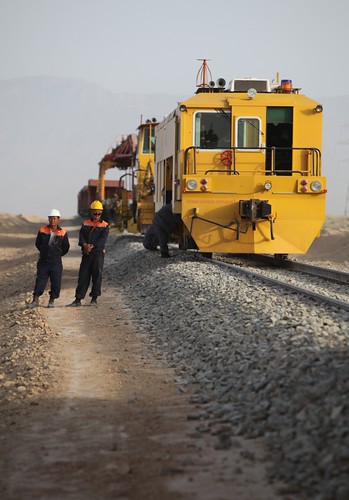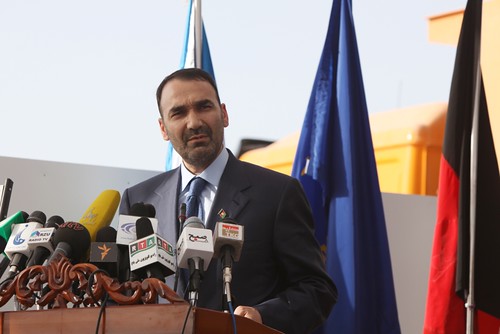Rerouting Logistics in Afghanistan
Recent events highlight both the possibilities and fragility of the International Security Assistance Force (ISAF) presence in Afghanistan nine years after Operation Enduring Freedom began, John CK Daly writes for ISN Security Watch.
By John CK Daly for ISN Security Watch
There were a number of items on the agenda for Afghan President Hamid Karzai’s four-day visit to Washington last week, from ongoing US support for NATO’s mission in Afghanistan to the political crisis in regional neighbor Kyrgyzstan, home to a major US airbase instrumental in supporting ISAF’s campaign.
Nine years into Operation Enduring Freedom, solidifying logistical support for the ISAF Afghan mission remains an issue of some concern in Washington. If the mantra of the preceding Bush administration toward developing the post-Soviet Caspian’s energy reserves was “happiness is multiple pipelines,” then a legacy of its Afghan campaign is an implicit “happiness is multiple logistical resupply routes.” Given the massive presence of ISAF forces, the value of these logistical transportation networks will only increase with time.
The scale of the problem
The logistical scope of resupplying western forces in Afghanistan is immense. According to ISAF spokesman Colonel Wayne Shanks, there are currently nearly 400 US and coalition bases in Afghanistan, ranging from the massive Bagram airbase down to camps, forward operating bases and combat outposts. According to the Pentagon, there are now 87,000 US troops in Afghanistan alongside 47,000 ISAF troops from 44 other countries. When the Obama administration surge is complete, by 2011 Afghanistan will host a total of 102,000 US troops.
Nor are these the only US personnel considerations: According to the Pentagon’s Central Command (CENTCOM), the number of contractors for the US military in Afghanistan is now 107,000. These forces are immensely costly; by the end of the 2010 fiscal year, Afghanistan will cost nearly $105 billion, which includes most of $33 billion in additional spending requested by the Obama administration and currently pending before Congress.
Logistical support
Virtually everything needed for these forces is brought into Afghanistan primarily through Pakistan. But the rising level of violence against the ‘traditional’ resupply routes through Pakistan has left the Pentagon seeking alternatives, most notably through Central Asia.
Currently, the Pentagon’s main logistical pipeline for supplying ISAF forces in Afghanistan remains Pakistan, where roughly three-quarters of supplies are shipped either through or via overflights. Ground supplies are shipped into Pakistan’s Karachi port on the Arabain Sea and offloaded onto trucks before being sent to one of five crossing points on the Afghan border, the most important being Torkham at the Khyber Pass and Baluchistan’s Chaman, both of which have been subjected to increasing militant attacks. Torkham is the shortest route for ISAF supplies to both Kabul and its adjacent Bagram Air Base, the largest US facility in Afghanistan, with about 4,000 Pakistani drivers delivering about 150 truckloads of supplies to Afghanistan each day.
The persistent vulnerability of the Pakistani logistical conduit and the attendant problems of supplying nearly a quarter of a million troops and ancillary personnel has led the Pentagon to develop options, most notably the Northern Distribution Network (NDN), a railway link running from Latvia’s Riga Baltic port through Russia and Kazakhstan terminating in Uzbekistan’s Termez on the Afghan border.
The Northern Distribution Network
The NDN is a joint initiative of multiple Department of Defense agencies, including the US Transportation Command, CENTCOM, the US European Command, the Defense Logistics Agency and the Department of State.
The NDN’s first shipment was sent on 20 February 2009 from Riga 3,212 miles to Termez, with US commanders stating that 100 containers daily would be transported via the NDN, nearly two-thirds of the 140 containers shipped through the Khyber Pass each day.
While CENTCOM, the US and Russian governments maintain that the NDN is designed to transit only ‘non-lethal’ cargoes, when last year ISN Security Watch asked Russian Foreign Minister Sergei Lavrov about the NDN he replied, “It’s only one year ago that we signed an agreement with NATO as an organization for non-lethal transit, but for many years lethal transit had been operating through Russia on the basis of our bilateral agreements with France, Germany, and recently the similar agreement with Spain was signed. They can move equipment, troops.” Despite the presence of major US and Russian media representatives, Lavrov’s comment was overlooked.
As Lavrov made his comments farther east, Uzbek President Islam Karimov announced that the airport in Navoi, Uzbekistan, was being used to transport non-lethal cargo into Afghanistan via South Korea’s Korean Air, officially handling Navoi’s logistics. Two months later, shortly before a visit by President Barack Obama to Moscow, Russian authorities announced that US troops and weapons could use the country’s airspace to reach Afghanistan.
Uzbekistan as a transit hub
Given the volatility of Pakistan, Pentagon logisticians are increasingly favoring Central Asian alternatives. Shifting from the high cost of airlifting cargo, several railway projects from Uzbekistan into northern Afghanistan are now underway. On 7 May, Afghan Finance Minister Omar Zakhelwal, while attending a meeting of the Asian Development Bank in Tashkent, announced that Japan had pledged $1 billion for railway building in Afghanistan for a line from Balkh to western Herat province.
The scope of the Japanese commitment is immense, as according to Zakhelwal, his Ministry’s revenue in 2009 was $1.3 billion. The Japanese commitment builds on earlier Uzbek efforts to assist its southern neighbor. Uzbekistan is helping upgrade Afghanistan’s only functioning railroad, the Termez-Hairatan line, linking Afghanistan’s northern provinces with the world and extending the Termez-Hairatan line to Mazar-e-Sharif.
Dr Fred Starr, chairman of Washington’s Central Asia-Caucasus Institute, told ISN Security Watch, “Afghanistan is the missing link in Eurasia’s rail network and Uzbekistan has taken a lead role in filling the gap. Everyone gains from this. No one loses.”
While the western military commitment in Afghanistan has led to infrastructure projects that languished for decades, roads, airports and railways are ‘dual-use’ technologies that will assist the post-war development of Afghanistan’s economy, decimated by decades of strife. An improved Afghan road and rail infrastructure will benefit all of Central Asia as well as provide cost-effective transport alternatives to aerial shipments. For all of the Taliban’s militancy, the rail and road upgrades are a Karzai administration economic ‘hearts and minds’ incentive for improving life in the countryside that the Taliban cannot counter, only attack.
Dr John CK Daly is a non-resident Fellow at John Hopkins Central Asia-Caucasus Institute in Washington, DC.

Creative Commons – Attribution-Noncommercial-No Derivative Works 3.0 Unported
Source: International Relations & Security Network, 2010-05-17


